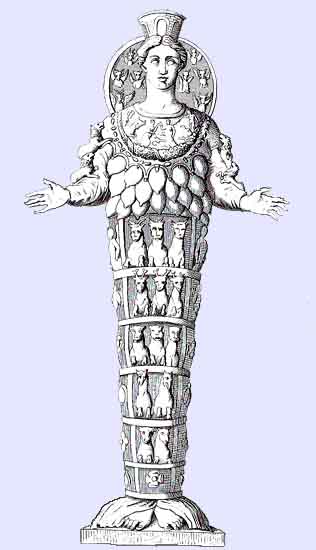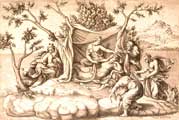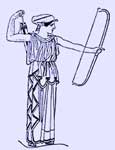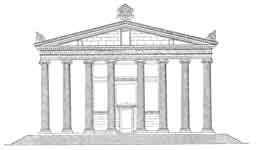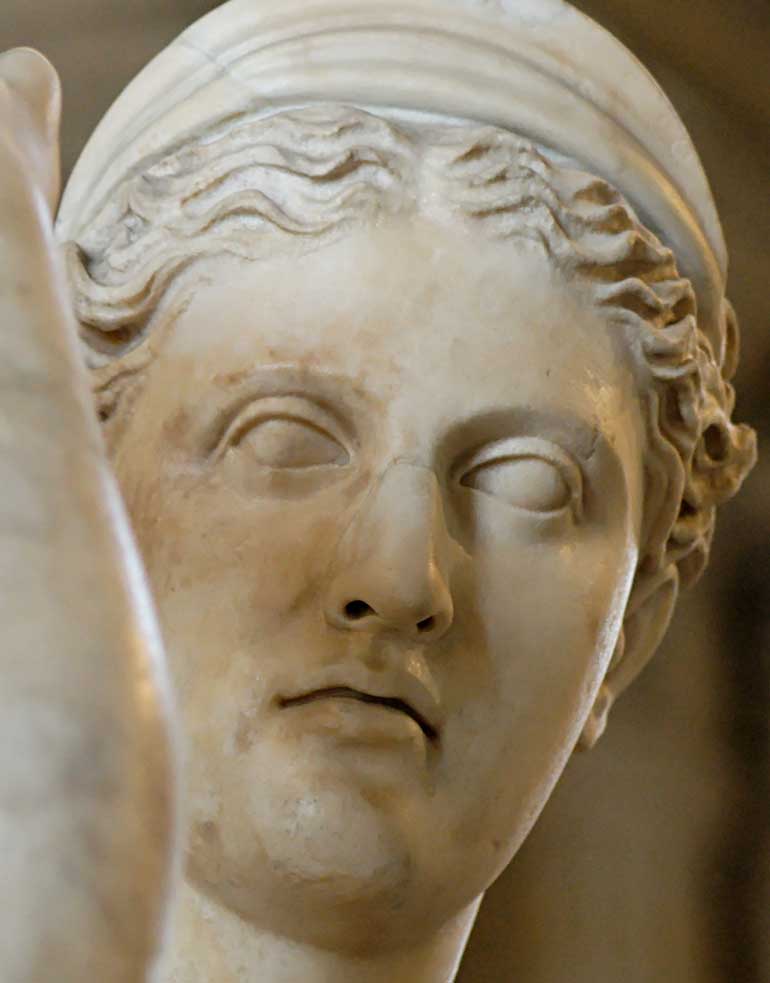
In Greek mythology Artemis (Greek Ἄρτεμις, Άρτεμις) is the daughter of Zeus and Leto and the twin sister of Apollo. In Roman mythology, she was known as Diana. In Etruscan mythology, she took the form of Artume.
She was the virgin moon goddess of the hunt, wild animals, healing, wilderness, chastity, and paradoxically childbirth (she was worshipped as a fertility/childbirth goddess mostly in cities), since she assisted her mother in the delivery of her twin. Early in her development, she was identified with Hecate, the primal, pre-Olympian feral goddess. She later became more identified with and eventually supplanted Selene as the moon goddess to complement her twin's identification with and supplantation of Helios as the sun god. Artemis also assimilated Caryatis (Carya).
Her priestesses were addressed with the title Melissa.
Artemis was not worshipped heavily in much of mainland Greece. In Asia Minor, however, she was a principal deity. The city of Ephesus is probably the best known of the Asian centers of her worship, from the story in the Acts of the Apostles, where the Ephesian metalsmiths who feel threatened by Paul's preaching of the new faith, zealously riot in her defense, shouting "Great is Diana of the Ephesians!" (Acts 19:28 KJV) In Rome, she was heavily venerated at Mount Tifata near Capua and in holy forests (such as Aricia, Latium) Her high priest lived in Aricia; his position was passed to the person who was able to kill him with a bough, picked from a tree in the forest.
Festivals in honor of Artemis include Brauronia, held in Brauron and the festival of Artemis Orthia in Sparta.
Young girls were initiated into the cult of Artemis at puberty. However, before marrying (an event in which they had little say, and which occurred shortly after puberty), they were asked to lay all the accoutrements of virginity (toys, dolls, locks of their hair) on an altar to Artemis.
Diana
Diana was worshipped in a temple on the Aventine Hill where mainly lower-class citizens and slaves worshipped her. Slaves could ask for and receive asylum in her temples.
She was worshipped at a festival on August 13.
Her name may come from diviana ("the shining one").
It is often presumed that defeated peoples become a substratum beneath that of their conquerors. It seems plausible that the association of Diana worship with slaves may reflect the conquest of Goddess worshippers by, presumably, the early Romans.
Artemis In Art
The oldest representations of Artemis in Greek Archaic art portray her as Potnia Theron ("Queen of the Beasts"): a winged goddess holding a stag and leopard in her hands, or sometimes a leopard and a lion. This winged Artemis lingered in ex-votos as Artemis Orthia, with a sanctuary close by Sparta.
In Greek classical art she is usually portrayed as a maiden huntress clothed in a girl's short skirt,[ with hunting boots, a quiver, a silver bow and arrows. Often she is shown in the shooting pose, and is accompanied by a hunting dog or stag. Her darker side is revealed in some vase paintings, where she is shown as the death-bringing goddess whose arrows fell young maidens and women, such as the daughters of Niobe.
The attributes of the goddess were often varied: bow and arrows were sometimes replaced by hunting spears; as a goddess of maiden dances she held a lyre; as a goddess of light a pair of flaming torches.
Only in post-Classical art do we find representations of Artemis-Diana with the crown of the crescent moon, as Luna. In the ancient world, although she was occasionally associated with the moon, she was never portrayed as the moon itself. Ancient statues of the goddesses can sometimes be found with crescent moons, however these are invariably Renaissance-era additions.
The Lady of Ephesus
In Ephesus, the Temple of Artemis became one the Seven Wonders of the World. In Ephesus, and elsewhere in Asia Minor, she was worshipped primarily as an earth and fertility goddess, akin to Cybele, unlike in mainland Greece. Statues in Greece depict her with her bow and arrow. In Asia Minor, she was often depicted with multiple rounded protuberances on her chest. They were formerly believed to be multiple breasts but are now known to have represented bull testes.
Birth
When Hera discovered that Leto was pregnant and that Hera's husband, Zeus, was the father, she banned Leto from giving birth on terra firma, or the mainland, or any island at sea. Leto found the floating island of Delos, which was neither mainland nor a real island and gave birth there. The island was surrounded by swans. As a gesture of gratitude, Delos was secured with four pillars. The island later became sacred to Apollo. Alternatively, Hera kidnapped Ilithyia, the goddess of childbirth, to prevent Leto from going into labor. The other gods forced Hera to let her go. Either way, Artemis was born first and then assisted with the birth of Apollo. Another version states that Artemis was born one day before Apollo, on the island of Ortygia * and that she helped Leto cross the sea to Delos the next day to give birth to Apollo.
*(Ortygia is assumed by some to be the ancient name of Delos)
Childhood
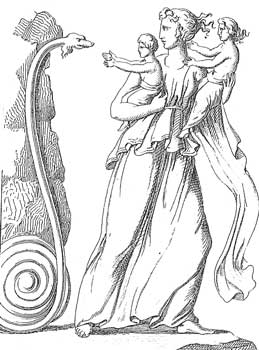
Leto with Apollo and Artemis
At three years old, Artemis asked her father, Zeus, while sitting on the god king's knee, to grant her several wishes. She asked for grant her perpetual virginity, lop-eared hounds, does to lead her chariot, and nymphs as her hunting companions. He granted her wishes. All of her companions remained virgins, and she guarded her chastity very closely.
Tales of Artemis and men
She was once bathing nude in the woods when the Theban prince and hunter Actaeon stumbled across her. He stopped and stared, amazed at her ravishing beauty. He was so stunned that he accidentally stepped on a twig, and Artemis noticed him. She was so disgusted at his stares that she changed him to a stag and set his own hounds to kill him. He was torn apart by the deadly hunting dogs, who never knew that the stag they were hunting was their own master. Alternatively, Actaeon boasted that he was a better hunter than she and Artemis turned him into a stag and he was eaten by his hounds.
Siproites
A Cretan, Siproites, saw Artemis bathing nude and was changed by her into a woman. (The complete story does not survive in any mythographer's works, but is mentioned offhand by Antoninus Liberalis.)
After leaving Eos, Orion became a follower of Artemis. She eventually killed him, though the reasons given vary:
- Orion and Artemis were engaged. Her brother, Apollo didn't believe it was appropriate for her to marry a mortal. Apollo convinced Orion to walk out into the water and then dared Artemis to try to hit the barely visible speck (actually Orion's head) with an arrow from the shore. She succeeded, killing him.
- Orion raped one of Artemis' female followers. She sent Scorpio, a scorpion, to kill him and both were placed in the stars as constellations. This legend explains why the constellation Scorpio rises just after Orion begins to set -- the scorpion still chases him. Orion's dog became Sirius, the dog-star.
Adonis
In some versions of the story of Adonis, Artemis or Ares (her lover in this story) sent a wild boar to kill Adonis. This version is suspect because it implies that Artemis had lain with Ares and by virtually all accounts, she remained chaste throughout time.
Other Stories
Callisto
Artemis killed any of her companions who lost their virginity, such as Maera and Callisto.
One of Artemis' companions, Callisto, lost her virginity to Zeus, who had come disguised as Artemis. Enraged, Artemis changed her into a bear. Callisto's son, Arcas, nearly killed his mother while hunting, but Zeus or Artemis stopped him and placed them both in the sky as Ursa Major and Ursa Minor.
Artemis punished Agamemnon after he killed a sacred deer in a sacred grove and boasted he was a better hunter. On his way to Troy to participate in the Trojan War, Agamemnon's ships were suddenly motionless as Artemis stopped the wind. An oracle named Calchis told Agamemnon that the only way to appease Artemis was to sacrifice Iphigenia, his daughter. According to some versions, he did so, but others claims that he sacrificed a deer in her place and Iphigenia was taken to Crimea to prepare others for sacrifice to Artemis.
A Queen of Thebes and wife of Amphion, Niobe boasted of her superiority to Leto because she had fourteen children (Niobids), seven male and seven female, while Leto had only two. Apollo killed her sons as they practiced athletics, with the last begging for his life, and Artemis her daughters. Apollo and Artemis used poisoned arrows to kill them, though according to some versions a number of the Niobids were spared (Chloris, usually). Amphion, at the sight of his dead sons, either killed himself or was killed by Apollo after swearing revenge. A devastated Niobe fled to Mount Siplyon in Asia Minor and turned into stone as she wept, or committed suicide. Her tears formed the river Achelous. Zeus had turned all the people of Thebes to stone and so no one buried the Niobids until the ninth day after their death, when the gods themselves entombed them.
Taygete
Taygete, one of the Pleiades,was a hunting companion of Artemis. When she was pursued by Zeus the nymph prayed to Artemis for help and was transformed into a cow. In thanks she afterwards dedicated five golden horned hinds to the goddess. (From Callimachus, Hymn to Artemis and a scholiast on Pindar's Olympian Ode 3)
Otus and Ephialtes
The Gigantes Otus and Ephialtes were a pair of brothers. At one point, they wanted to storm Mt. Olympus. They managed to kidnap Ares and hold him in a jar for thirteen months. Artemis later changed herself into a deer and ran between them. The Aloadae, not wanting her to get away because they were eager huntsmen, each threw thier javelin and simultaneously killed each other.
The Meleagrids
After the death of Meleager, Artemis turned her grieving sisters, the Meleagrids into guineafowl.
Chione
Artemis killed Chione for her pride and vanity.
Atalanta and Oeneus
Artemis saved the infant Atalanta from dying of exposure after her father abandoned her. She sent a female bear to suckle the baby, who was then raised by hunters.
Among other adventures, Atalanta participated in the hunt for the Calydonian Boar, which Artemis had sent to destroy Calydon because King Oeneus had forgotten her at the harvest sacrifices. In the hunt, Atalanta drew the first blood, and was awarded the prize of the skin. She hung it in a sacred grove at Tegea as a dedication to Artemis.
Epithets
Agne, Parthenos, Aodoie, Prothyraia, Prostatria, Agoraia, Kleidouchos, Patroa, Eleuthera,
Agrotera was a title of the goddess as the patron of hunters. The ancient Spartans used to sacrifice to her as their patron goddess before starting a new military campaign.
Amarynthia from a festival in her honor initially held originally at Amarynthus in Euboea
Astrateia, a surname of Artemis, under which she had a temple near Pyrrhichus in Laconia, because she was believed to have stopped there the progress of the Amazons. (Pausanias 3.25. 2.)
Caryatis (Καρυᾶτις), a surname of Artemis, derived from the town of Caryae in Laconia. Here the statue of the goddess stood in the open air, and maidens celebrated a festival to her every year with dances. (Pausanias iii. 10. § 8, iv. 16. § 5 ; Serv. ad Virg. Eclog. viii. 30.)
Cynthia, from her birthplace on Mount Cynthus on Delos,
Hemeresia (Ἡμερησία), i.e. the soothing goddess, a surname of Artemis, under which she was worshipped at the well Lusi (Λουσοί), in Arcadia. (Pausanias viii. 18. § 3; Callim. Hymn. in Dian. 236.)
Kourotrophos, as the nurse of youths.
Laphria A name given to Artemis as worshipped at a festival called Laphria Λάφρια, celebrated at Patrae in Achaia (Pausanias iv. 31. 6).
Locheia, as the goddess of childbirth and midwives.
Lyceia (gr. Lykeia), a surname of Artemis, under which she had a temple at Troezene, built by Hippolytus. (Paus. 2.31.6.)
Lycoatis (gr. Lykoatis), a surname of Artemis, who had a temple at Lycoa, in Arcadia. (Pausanias 8.36.5.)
Phoebe, the feminine form of her brother Apollo's epithet Phoebus.
Orthia (Ὀρθία) A name given to Artemis, as worshipped at Limnaeum, in Laconia, where boys were severely scourged at her altar (Pausanias iii. 16, 7). (Diamastigosis)
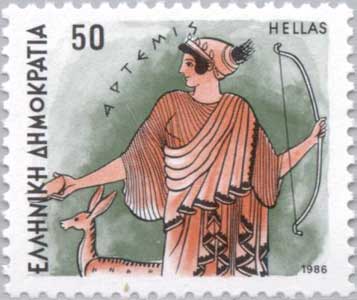
Artemis (Diana), the daughter of Zeus and Leto, known also as Mistress of Beasts (Potnia Theron).
Potnia Theron, as the patron of wild animals; Homer used this title
Triclaria, See Pausanias, Triclaria Festival, 7.19
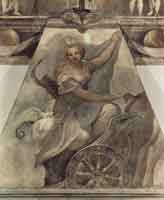
Stamps

Links
| Olympians |
| Zeus and Hera |
| Poseidon, Hades, |
| Hestia, Demeter, |
| Aphrodite, Athena, |
| Apollo, Artemis, |
| Ares, Hephaestus, |
| Hermes, Dionysus |
Asteroid 105 Artemis
- Greek Religion, Walter Burkert
- The Greek Myths: The Complete And Definitive Edition, Robert Graves
- Gods of the Greeks, Carl Kerenyi
See also : Greek Mythology. Paintings, Drawings
Retrieved from "http://en.wikipedia.org/"
All text is available under the terms of the GNU Free Documentation License
| Ancient Greece
Science, Technology , Medicine , Warfare, , Biographies , Life , Cities/Places/Maps , Arts , Literature , Philosophy ,Olympics, Mythology , History , Images Medieval Greece / Byzantine Empire Science, Technology, Arts, , Warfare , Literature, Biographies, Icons, History Modern Greece Cities, Islands, Regions, Fauna/Flora ,Biographies , History , Warfare, Science/Technology, Literature, Music , Arts , Film/Actors , Sport , Fashion --- |

